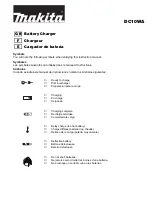
14
X-pert Charger X50
EN
Warnings and safety notes
CE approval regulations -
fire hazard!
•
WARNING:
do not use outdoors. Protect the charger from damp, rain and heat
-
fire hazard!
•
WARNING:
Connect the charger to a suitable and adequately dimensioned power supply. The
charger is suitable for 12 V DC or 100 - 240 V AC. Always connect to only one input, also never plug an
AC voltage to the 12 V DC input or a DC voltage to the 100 - 240 V AC input -
fire hazard!
•
WARNING:
If the charger is connected to a built-in car car battery, turn off the car engine. During
charging, do not connect an additional car battery charger -
fire hazard!
•
WARNING:
Provide good ventilation! Do not cover the cooling openings in the case -
fire hazard!
•
WARNING
:
the charger and the battery to be charged should be set up on a heat-resistant, non-
inflammable and non-conductive surface before use. The charging process must be supervised by an
adult
-
fire hazard!
•
WARNING:
Select the correct cell type (eg. Ni-MH or Li-Po) before the start of the charging process.
Never charge with incorrectly set cell type. Check the maximum charge current specified by the manu-
facturer of the battery -
fire hazard!
•
WARNING:
never connect the charging cables together or with the power supply connection
cables -
fire hazard!
• WARNING:
Always connect only one battery to the charger output. If multiple batteries are connected
in parallel or in series, definitely pay attention to the same cell type, cell count, capacity and charging
status -
fire hazard!
• Keep all inflammable and volatile materials well away from the charging area.
• Disconnect the charger from the power supply after use.
Charging informations
•
WARNING:
NiMH or lead acid batteries are usually charged with 1/10 of the nominal value of the
capacity specified - eg. batteries with a capacity of 2.0 Ah the normal charging current is 200 mA. Only
when specifically designated as fast rechargeable batteries the normal charging current may be exceeded
-
fire or explosion hazard!
•
WARNING:
Lithium batteries (LiPo, Li-Ion or LiFe) are usually charged with 1C, eg. batteries with a
capacity of 2.0 Ah the charging current is 2 A. Is no maximum charge current (or charge C-rate) noted on
the battery, 1C may not be exceeded. Only when specifically designated as fast rechargeable batteries
the normal charging current may be exceeded -
Fire or explosion hazard!
• New Ni-MH batteries (also long stored) may cause an early shutdown in the Delta-peak mode. New bat-
teries usually achieve its full capacity after several charges.
•
WARNING:
after charging the battery pack must have a uniform temperature, if not, or when a cell
gets much warmer than the others, this indicates a cell failure. Stop using the battery pack in any case, it
must be immediately disposed -
fire or explosion hazard!
•
NOTE:
the maximum charging current can be limited by the power of the charger, this means it is
not guaranteed to reach the preset value. For example, if you want to charge a 3S Li-Po battery with a
50 W charger, the charger can deliver only about 4.5 A charging current at the nominal battery voltage
of 11.1 volts.
•
WARNING:
do not expose batteries / rechargeable batteries to heat or throw into fire -
fire or
explosion hazard!
•
WARNING:
insert batteries / rechargeable batteries with the correct polarity, no short-circuiting -
fire or explosion hazard!















































